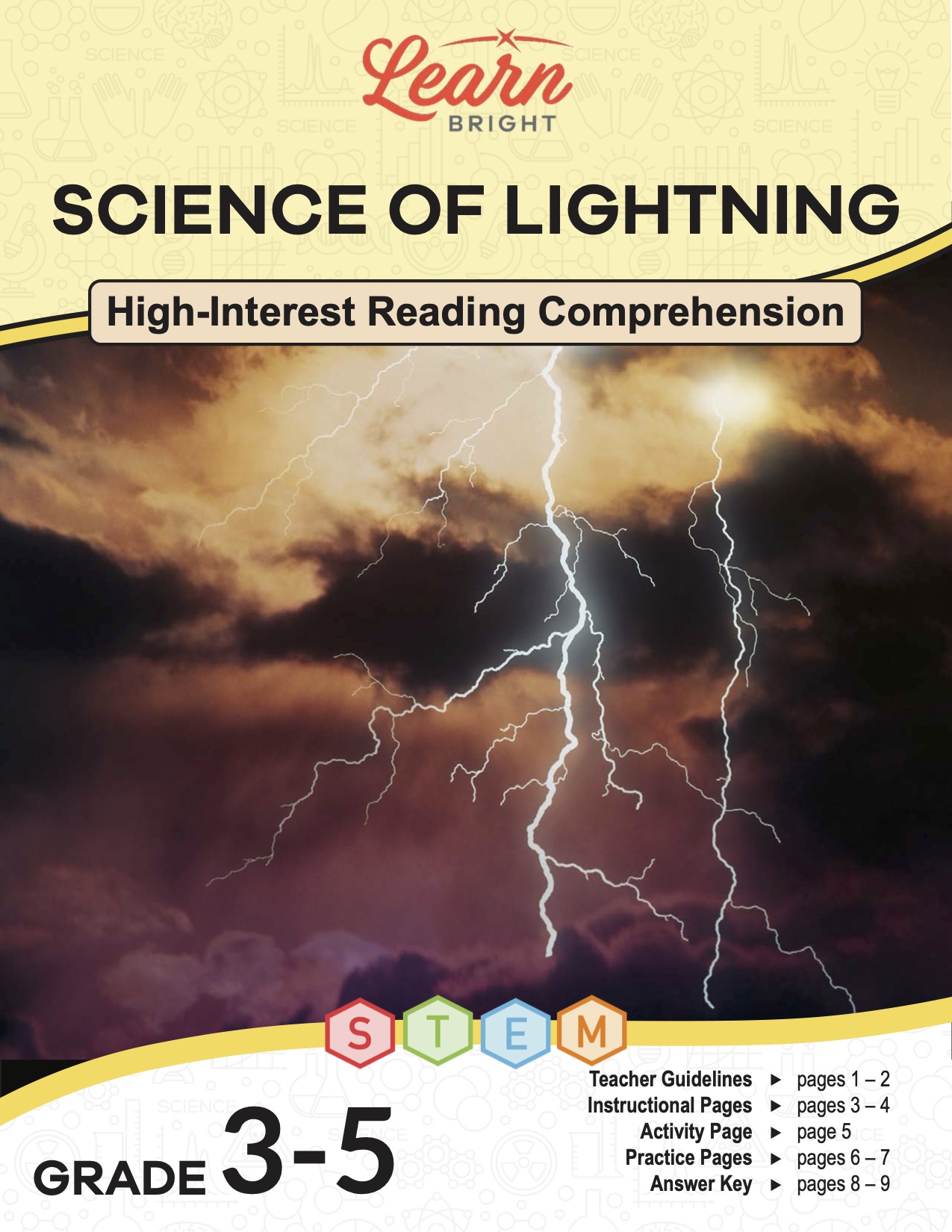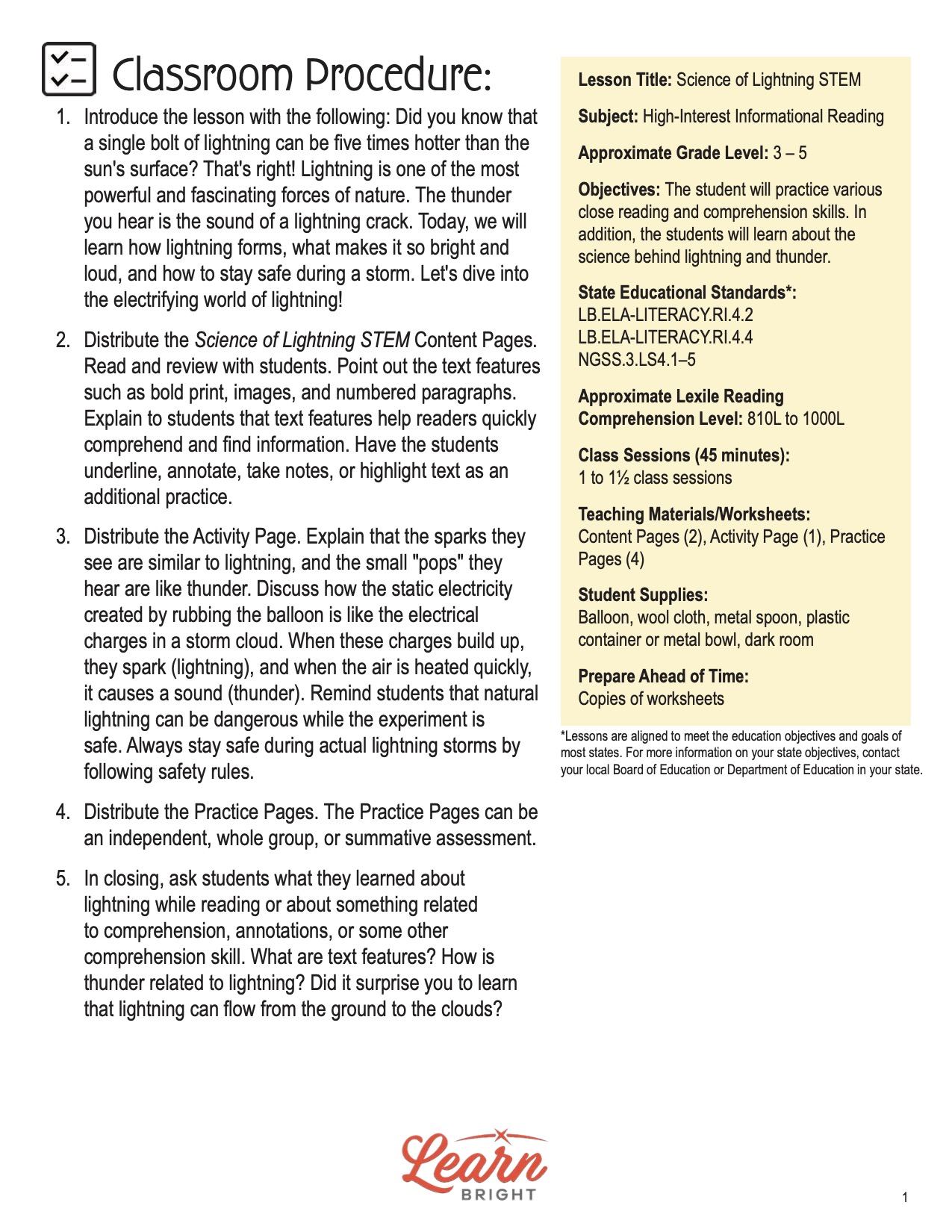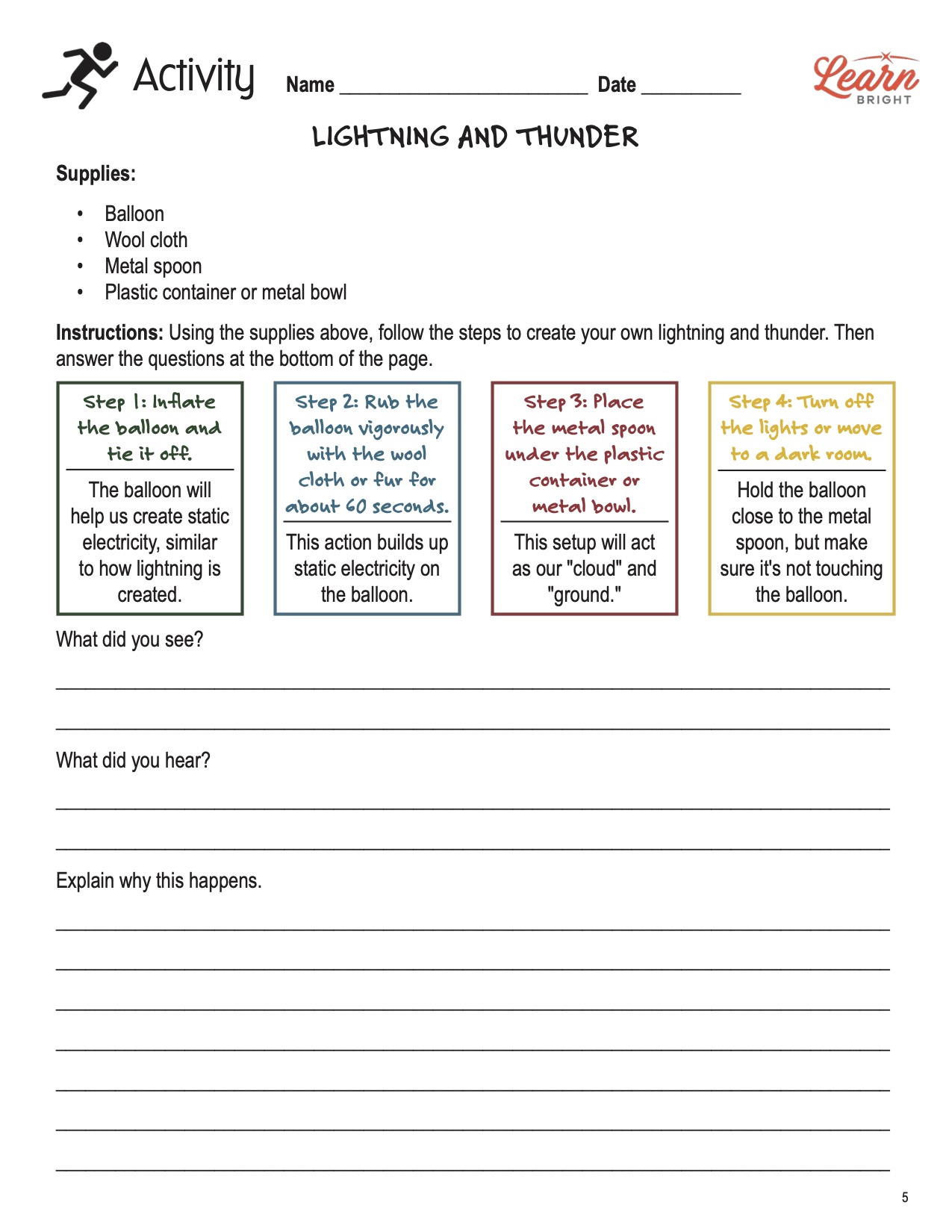Description
What our Science of Lightning STEM lesson plan includes
Lesson Objectives and Overview: Science of Lightning STEM is a high-interest reading comprehension lesson plan. As such, students will practice various close reading and comprehension skills. In addition, they will learn about the science behind lightning and thunder. This lesson is for students in 3rd grade, 4th grade, and 5th grade.
Classroom Procedure
Every lesson plan provides you with a classroom procedure page that outlines a step-by-step guide to follow. You do not have to follow the guide exactly. The guide helps you organize the lesson and details when to hand out worksheets. It also lists information in the yellow box that you might find useful. You will find the lesson objectives, state standards, and number of class sessions the lesson should take to complete in this area. In addition, it describes the supplies you will need as well as what and how you need to prepare beforehand. The activity for this lesson requires balloons, wool cloth, metal spoons, plastic containers or metal bowls, and a dark room.
Teacher Notes
The teacher notes page provides an extra paragraph of information to help guide the lesson and remind you what to focus on. It explains that you can teach this lesson in a whole-class setting or as an independent, small-group activity. The blank lines on this page are available for you to write out thoughts and ideas you have as you prepare the lesson.
SCIENCE OF LIGHTNING STEM LESSON PLAN CONTENT PAGES
What Is Lightning?
The Science of Lightning STEM lesson plan contains two content pages. Have you ever seen a bright flash in the sky, followed by a loud boom? That’s thunder and lightning! Here’s a question for you. Does lightning go from the sky down, or from the ground up? According to the National Severe Storms Laboratory of the NOAA (National Ocean and Atmospheric Administration), the answer is both. Cloud-to-ground lightning starts as an invisible channel of negative charge, called a stepped leader, that moves downward from the cloud in a zigzag pattern. When the stepped leader reaches an object on the ground, a surge of electricity from the ground moves upward to the clouds, producing the visible lightning strike. All this occurs in less time than it takes to blink.
Lightning, then, is basically a huge spark of electricity. It happens because of the buildup of electrical charges in clouds. Inside a storm cloud, tiny ice crystals and water droplets bump into each other. This creates static electricity, like when you rub a balloon on your hair and it sticks to you. The electricity in the cloud needs to find a way to the ground, and it does this by making a lightning bolt.
When lightning strikes, it’s incredibly bright. The bright flash is caused by the rapid heating of the air around the lightning bolt. The air gets so hot that it expands quickly, making the loud noise we hear as thunder. Thunder is the sound of the air rushing back to its normal state after being heated. This is why thunder can rumble and roll for a long time.
The Power of Lightning
Lightning can be very powerful and cause quite a lot of damage. It can strike trees, buildings, and even people. That’s why it’s essential to stay inside during a lightning storm. If you’re outside and you see lightning, find a safe place to stay, such as inside a building or a car. Avoid standing under tall objects like trees, since they can attract lightning.
Storm clouds that create lightning are called cumulonimbus clouds. These tall clouds can reach up into the stratosphere, the second layer of Earth’s atmosphere. Inside these clouds, the conditions are perfect for lightning to form. The top of the cloud can be icy, while the bottom of the cloud is warmer. This difference in temperature helps create the electrical charges necessary for lightning.
Lightning actually plays a vital role in nature. It helps produce nitrogen compounds in the atmosphere. Plants need nitrogen to grow; lightning helps make this nitrogen available in the soil. So, in a way, lightning helps plants grow and keeps the environment healthy!
Types of Lightning
There are different types of lightning you might have observed during a storm. One common type is called “cloud-to-ground” (CG) lightning. This is when the lightning bolt travels from the cloud to the ground. Another type is “cloud-to-cloud” (CC) lightning, which happens between two clouds. There is also “intra-cloud” (IC) lightning, which occurs inside a single cloud. “Ground-to-cloud” (GC) lightning strikes are sometimes called upward-moving lightning. It appears on tall towers and skyscrapers. Each type of lightning looks different and can be seen in various ways.
Lightning can also be very colorful. Sometimes, you might see red, blue, or purple flashes. This happens because the lightning bolt can heat the air to different temperatures, making it glow in various colors. The particles and gases in the air can also affect the colors.
Scientists use special tools to study lightning. One tool is called a lightning detector. It can sense when lightning strikes and where it happens. This helps meteorologists, the scientists who study weather, predict storms and keep people safe. Lightning detectors are often used in weather stations to monitor storms and provide warnings.
Next time you see a flash of lightning and hear a boom of thunder, you’ll know what’s happening. Lightning is a powerful and exciting part of nature that helps improve our world. And remember, if you’re ever caught in a storm, stay safe and wait for the lightning to pass before you go back outside.
SCIENCE OF LIGHTNING STEM LESSON PLAN WORKSHEETS
The Science of Lightning STEM lesson plan includes two worksheets: an activity worksheet and a practice worksheet. Each one will help students solidify their grasp of the material they learned throughout the lesson. You can refer to the classroom procedure guidelines to know when to hand out each worksheet.
LIGHTNING AND THUNDER STEM ACTIVITY WORKSHEET
For the activity, students will create their own lightning and thunder. First, they will use the supplies listed on the page and follow the steps. Once they finish, they will answer the questions at the bottom of the page.
REVIEW PRACTICE WORKSHEET
The practice worksheet requires students to answer a series of 10 questions. These questions all relate to the content pages, so students will need to refer to them often for the answers. In addition, each question provides which reading tool the question corresponds to, such as text feature, vocabulary, or comprehension.
Worksheet Answer Keys
At the end of the lesson plan document is an answer key for the practice worksheet. The correct answers are all in red to make it easier for you to compare them with students’ responses. If you choose to administer the lesson pages to your students via PDF, you will need to save a new file that omits these pages. Otherwise, you can simply print out the applicable pages and keep these as reference for yourself when grading assignments.









